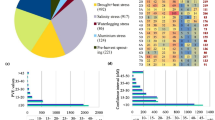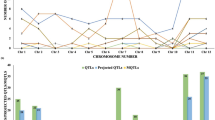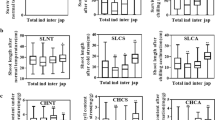Key Message
By integrating genetics and genomics data, reproductive tissues-specific and heat stress responsive 35 meta-QTLs and 45 candidate genes were identified, which could be exploited through marker-assisted breeding for fast-track development of heat-tolerant rice cultivars.
Abstract
Rice holds the key to future food security. In rice-growing areas, temperature has already reached an optimum level for growth, hence, any further increase due to global climate change could significantly reduce rice yield. Several mapping studies have identified a plethora of reproductive tissue-specific and heat stress associated inconsistent quantitative trait loci (QTL), which could be exploited for improvement of heat tolerance. In this study, we performed a meta-analysis on previously reported QTLs and identified 35 most consistent meta-QTLs (MQTLs) across diverse genetic backgrounds and environments. Genetic and physical intervals of nearly 66% MQTLs were narrower than 5 cM and 2 Mb respectively, indicating hotspot genomic regions for heat tolerance. Comparative analyses of MQTLs underlying genes with microarray and RNA-seq based transcriptomic data sets revealed a core set of 45 heat-responsive genes, among which 24 were reproductive tissue-specific and have not been studied in detail before. Remarkably, all these genes corresponded to various stress associated functions, ranging from abiotic stress sensing to regulating plant stress responses, and included heat-shock genes (OsBiP2, OsMed37_1), transcription factors (OsNAS3, OsTEF1, OsWRKY10, OsWRKY21), transmembrane transporters (OsAAP7A, OsAMT2;1), sugar metabolizing (OsSUS4, α-Gal III) and abiotic stress (OsRCI2-7, SRWD1) genes. Functional data evidences from Arabidopsis heat-shock genes also suggest that OsBIP2 may be associated with thermotolerance of pollen tubes under heat stress conditions. Furthermore, promoters of identified genes were enriched with heat, dehydration, pollen and sugar responsive cis-acting regulatory elements, proposing a common regulatory mechanism might exist in rice for mitigating reproductive stage heat stress. These findings strongly support our results and provide new candidate genes for fast-track development of heat-tolerant rice cultivars.





Similar content being viewed by others
Code availability
Not applicable.
References
Akaike H (1998) A bayesian analysis of the minimum AIC procedure. Selected Papers of Hirotugu Akaike. Springer, Berling, pp 275–280
Bahuguna RN, Jha J, Pal M, Shah D, Lawas LM, Khetarpal S, Jagadish KS (2015) Physiological and biochemical characterization of NERICA-L-44: a novel source of heat tolerance at the vegetative and reproductive stages in rice. Physiol Plant 154:543–559
Baniwal SK et al (2004) Heat stress response in plants: a complex game with chaperones and more than twenty heat stress transcription factors. J Biosci 29:471–487
Bargsten JW, Nap J-P, Sanchez-Perez GF, van Dijk AD (2014) Prioritization of candidate genes in QTL regions based on associations between traits and biological processes. BMC Plant Biol 14:330
Bashir K, Matsui A, Rasheed S, Seki M (2019) Recent advances in the characterization of plant transcriptomes in response to drought, salinity, heat, and cold stress. F1000 Res. https://doi.org/10.12688/f1000research.18424.1
Bhuria M, Goel P, Kumar S, Singh AK (2016) The promoter of AtUSP is co-regulated by phytohormones and abiotic stresses in Arabidopsis thaliana. Front Plant Sci 7:1957
Buu BC et al (2014) Quantitative trait loci associated with heat tolerance in rice (Oryza sativa L.). Plant Breed Biotechnol 2:14–24
Cao L, Zhao J, Zhan X, Li D, He L, Cheng S (2003) Mapping QTLs for heat tolerance and correlation between heat tolerance and photosynthetic rate in rice. Chin J Rice Sci 17:223–227
Cao Z et al (2020) Fine mapping of the qHTB1–1 QTL, which confers heat tolerance at the booting stage, using an Oryza rufipogon Griff. introgression line. Theor Appl Genet 133:1161–1175
Cheng L-R et al (2012) Genetic analysis of cold tolerance at seedling stage and heat tolerance at anthesis in rice (Oryza sativa L.). J Integr Agric 11:359–367
Confalonieri R, Rosenmund AS, Baruth B (2009) An improved model to simulate rice yield. Agron Sustain Dev 29:463–474
Darvasi A, Soller M (1997) A simple method to calculate resolving power and confidence interval of QTL map location. Behav Genet 27:125–132
Darzi-Ramandi H, Shariati JV, Tavakol E, Najafi-Zarini H, Bilgrami SS, Razavi K (2017) Detection of consensus genomic regions associated with root architecture of bread wheat on groups 2 and 3 chromosomes using QTL meta-analysis. Aust J Crop Sci 11:777
Goffinet B, Gerber S (2000) Quantitative trait loci: a meta-analysis. Genetics 155:463–473
González-Schain N et al (2016) Genome-wide transcriptome analysis during anthesis reveals new insights into the molecular basis of heat stress responses in tolerant and sensitive rice varieties. Plant Cell Physiol 57:57–68
Hakata M, Wada H, Masumoto-Kubo C, Tanaka R, Sato H, Morita S (2017) Development of a new heat tolerance assay system for rice spikelet sterility. Plant Methods 13:34
Hasanuzzaman M, Nahar K, Alam M, Roychowdhury R, Fujita M (2013) Physiological, biochemical, and molecular mechanisms of heat stress tolerance in plants. Int J Mol Sci 14:9643–9684
Hassani-Pak K, Castellote M, Esch M, Hindle M, Lysenko A, Taubert J, Rawlings C (2016) Developing integrated crop knowledge networks to advance candidate gene discovery. Appl Transl Genom 11:18–26
Higo K, Ugawa Y, Iwamoto M, Korenaga T (1999) Plant cis-acting regulatory DNA elements (PLACE) database: 1999. Nucleic Acids Res 27:297–300
Horton P, Park K-J, Obayashi T, Fujita N, Harada H, Adams-Collier C, Nakai K (2007) WoLF PSORT: protein localization predictor. Nucleic Acids Res 35:W585–W587
Hwang Y-S, Karrer E, Thomas B, Chen L, Rodriguez R (1998) Three cis-elements required for rice α-amylase Amy3D expression during sugar starvation. Plant Mol Biol 36:331–341
Jagadish S, Craufurd P, Wheeler T (2007) High temperature stress and spikelet fertility in rice (Oryza sativa L.). J Exp Bot 58:1627–1635
Jagadish S, Cairns J, Lafitte R, Wheeler TR, Price A, Craufurd PQ (2010a) Genetic analysis of heat tolerance at anthesis in rice. Crop Sci 50:1633–1641
Jagadish S, Muthurajan R, Oane R, Wheeler TR, Heuer S, Bennett J, Craufurd PQ (2010b) Physiological and proteomic approaches to address heat tolerance during anthesis in rice (Oryza sativa L.). J Exp Bot 61:143–156
Jain M (2012) Next-generation sequencing technologies for gene expression profiling in plants. Brief Funct Genom 11:63–70
Khahani B, Tavakol E, Shariati V (2019) Genome-wide meta-analysis on yield and yield-related QTLs in barley (Hordeum vulgare L.). Mol breed 39:56
Kilasi NL, Singh J, Vallejos CE, Ye C, Jagadish S, Kusolwa P, Rathinasabapathi B (2018) Heat stress tolerance in rice (Oryza sativa L.): identification of quantitative trait loci and candidate genes for seedling growth under heat stress. Front Plant Sci 9:1578
Krishnan P, Ramakrishnan B, Reddy KR, Reddy V (2011) High-temperature effects on rice growth, yield, and grain quality. Advances in agronomy, vol 111. Elsevier, Amsterdam, pp 87–206
Lafarge T, Bueno C, Frouin J, Jacquin L, Courtois B, Ahmadi N (2017) Genome-wide association analysis for heat tolerance at flowering detected a large set of genes involved in adaptation to thermal and other stresses. PLoS ONE 12:e0171254
Liu L, Mei Q, Yu Z, Sun T, Zhang Z, Chen M (2013) An integrative bioinformatics framework for genome-scale multiple level network reconstruction of rice. J Integr Bioinform 10:94–102
Liu G et al (2020) Dynamic transcriptome analysis of anther response to heat stress during anthesis in thermotolerant rice (Oryza sativa L.). Int J Mol Sci 21:1155
Ma Z-X, Leng Y-J, Chen G-X, Zhou P-M, Ye D, Chen L-Q (2015) The thermosensitive male sterile 1 interacts with the BiPs via DnaJ domain and stimulates their ATPase enzyme activities in Arabidopsis. PloS one 10
Martinez AK, Soriano JM, Tuberosa R, Koumproglou R, Jahrmann T, Salvi S (2016) Yield QTLome distribution correlates with gene density in maize. Plant Sci 242:300–309
Maruyama A, Weerakoon W, Wakiyama Y, Ohba K (2013) Effects of increasing temperatures on spikelet fertility in different rice cultivars based on temperature gradient chamber experiments. J Agron Crop Sci 199:416–423
Mittal D, Madhyastha DA, Grover A (2012) Genome-wide transcriptional profiles during temperature and oxidative stress reveal coordinated expression patterns and overlapping regulons in rice. PLoS ONE 7:e40899
Narusaka Y et al (2003) Interaction between two cis-acting elements, ABRE and DRE, in ABA-dependent expression of Arabidopsis rd29A gene in response to dehydration and high-salinity stresses. Plant J 34:137–148
Nover L, Bharti K, Döring P, Mishra SK, Ganguli A, Scharf K-D (2001) Arabidopsis and the heat stress transcription factor world: how many heat stress transcription factors do we need? Cell Stress Chaperones 6:177
O'Neill SD, Kumagai MH, Majumdar A, Huang N, Sutliff TD, Rodriguez RL (1990) The α-amylase genes in Oryza sativa: characterization of cDNA clones and mRNA expression during seed germination. Mol General Genet MGG 221:235–244
Peraudeau S et al (2015) Effect of carbohydrates and night temperature on night respiration in rice. J Exp Bot 66:3931–3944
Poli Y et al (2013) Characterization of a Nagina22 rice mutant for heat tolerance and mapping of yield traits. Rice 6:36
Prasad PV, Bheemanahalli R, Jagadish SK (2017) Field crops and the fear of heat stress—opportunities, challenges and future directions. Field Crops Res 200:114–121
Qingquan C, Sibin Y, Chunhai L (2008) Identification of QTLs for heat tolerance at flowering stage in rice. Sci Agric Sin
Raza Q, Riaz A, Sabar M, Atif RM, Bashir K (2019) Meta-analysis of grain iron and zinc associated QTLs identified hotspot chromosomal regions and positional candidate genes for breeding biofortified rice. Plant Sci 288:110214
Rieping M, Schöffl F (1992) Synergistic effect of upstream sequences, CCAAT box elements, and HSE sequences for enhanced expression of chimaeric heat shock genes in transgenic tobacco. Mol General Genet MGG 231:226–232
Sakai H et al (2013) Rice annotation project database (RAP-DB): an integrative and interactive database for rice genomics. Plant Cell Physiol 54:e6–e6
Sakurai H, Enoki Y (2010) Novel aspects of heat shock factors: DNA recognition, chromatin modulation and gene expression. FEBS J 277:4140–4149
Satake T, Yoshida S (1978) High temperature-induced sterility in indica rices at flowering. Jpn J Crop Sci 47:6–17
Sato Y et al (2011a) RiceXPro: a platform for monitoring gene expression in japonica rice grown under natural field conditions. Nucleic Acids Res 39:D1141–D1148
Sato Y et al (2011b) Field transcriptome revealed critical developmental and physiological transitions involved in the expression of growth potential in japonica rice. BMC Plant Biol 11:10
Scafaro AP, Atwell BJ, Muylaert S, Reusel BV, Ruiz GA, Rie JV, Gallé A (2018) A thermotolerant variant of Rubisco activase from a wild relative improves growth and seed yield in rice under heat stress. Front Plant Sci 9:1663
Shah F, Huang J, Cui K, Nie L, Shah T, Chen C, Wang K (2011) Impact of high-temperature stress on rice plant and its traits related to tolerance. J Agric Sci 149:545–556
Shanmugavadivel P, Sv AM, Prakash C, Ramkumar M, Tiwari R, Mohapatra T, Singh NK (2017) High resolution mapping of QTLs for heat tolerance in rice using a 5K SNP array. Rice 10:28
Shanmugavadivel P, Prakash C, Mithra SA (2019) Molecular approaches for dissecting and improving drought and heat tolerance in rice. Advances in rice research for abiotic stress tolerance. Elsevier, Amsterdam, pp 839–867
Sharma N, Russell SD, Bhalla PL, Singh MB (2011) Putative cis-regulatory elements in genes highly expressed in rice sperm cells. BMC Res Notes 4:319
Singh UM, Yadav S, Dixit S, Ramayya PJ, Devi MN, Raman KA, Kumar A (2017) QTL hotspots for early vigor and related traits under dry direct-seeded system in rice (Oryza sativa L.). Front Plant Sci 8:286
Sosnowski O, Charcosset A, Joets J (2012) BioMercator V3: an upgrade of genetic map compilation and quantitative trait loci meta-analysis algorithms. Bioinformatics 28:2082–2083
Temnykh S, DeClerck G, Lukashova A, Lipovich L, Cartinhour S, McCouch S (2001) Computational and experimental analysis of microsatellites in rice (Oryza sativa L.): frequency, length variation, transposon associations, and genetic marker potential. Genome Res 11:1441–1452
Udawela U, Ananda G, Karunarathne S, Sooriyapathirana S, Li F, Liu Z (2018) Development of heat tolerant introgression lines and preliminary quantitative trait loci (QTL) analysis at flowering stage in Oryza sativa L. J Nat Sci Found Sri Lanka 46:253–270
von Gromoff ED, Schroda M, Oster U, Beck CF (2006) Identification of a plastid response element that acts as an enhancer within the Chlamydomonas HSP70A promoter. Nucleic Acids Res 34:4767–4779
Wilkins O et al (2016) EGRINs (environmental gene regulatory influence networks) in rice that function in the response to water deficit, high temperature, and agricultural environments. Plant Cell 28:2365–2384
Xiao Y-H, Yi P, Luo L-H, Deng H-B, Zhang G-L, Tang W-B, Chen L-Y (2011a) Quantitative trait loci associated with pollen fertility under high temperature stress at flowering stage in rice (Oryza sativa). Rice Sci 18:204–209
Xiao Y et al (2011b) Quantitative trait loci associated with seed set under high temperature stress at the flowering stage in rice (Oryza sativa L.). Euphytica 178:331–338
Yadav A et al (2020) Heat shock proteins: master players for heat-stress tolerance in plants during climate change. Heat stress tolerance in plants: physiological, molecular and genetic perspectives, 1st edn. Wiley, Hoboken, pp 189–211
Yamaguchi-Shinozaki K, Shinozaki K (2005) Organization of cis-acting regulatory elements in osmotic-and cold-stress-responsive promoters. Trends Plant Sci 10:88–94
Yang KZ et al (2009) A mutation in Thermosensitive Male Sterile 1, encoding a heat shock protein with DnaJ and PDI domains, leads to thermosensitive gametophytic male sterility in Arabidopsis. Plant J 57:870–882
Ye C et al (2012) Mapping QTL for heat tolerance at flowering stage in rice using SNP markers. Plant Breed 131:33–41
Ye C et al (2015a) Identifying and confirming quantitative trait loci associated with heat tolerance at flowering stage in different rice populations. BMC Genet 16:41
Ye C, Tenorio FA, Redoña ED, Morales-Cortezano PS, Cabrega GA, Jagadish KS, Gregorio GB (2015b) Fine-mapping and validating qHTSF4. 1 to increase spikelet fertility under heat stress at flowering in rice. Theor Appl Genet 128:1507–1517
Yin X, Kropff MJ, Goudriaan J (1996) Differential effects of day and night temperature on development to flowering in rice. Ann Bot 77:203–213
Zhang T, Yang L, Jiang K, Huang M, Sun Q, Chen W, Zheng J (2008) QTL mapping for heat tolerance of the tassel period of rice. Mol Plant Breed 6:867–873
Zhang G-L, Chen L-Y, Xiao G-Y, Xiao Y-H, Chen X-B, Zhang S-T (2009) Bulked segregant analysis to detect QTL related to heat tolerance in rice (Oryza sativa L.) using SSR markers. Agric Sci China 8:482–487
Zhang X et al (2012) Expression profile in rice panicle: insights into heat response mechanism at reproductive stage. PLoS ONE 7:e49652
Zhang C et al (2018) Heat stress induces spikelet sterility in rice at anthesis through inhibition of pollen tube elongation interfering with auxin homeostasis in pollinated pistils. Rice 11:1–12
Zhao Z, Jiang L, Xiao Y, Zhang W, Zhai H, Wan J (2006) Identification of QTLs for heat tolerance at the booting stage in rice (Oryza saliva L.). Zuo Wu Xue Bao 32:640–644
Zhao L et al (2016) Mapping quantitative trait loci for heat tolerance at anthesis in rice using chromosomal segment substitution lines. Breed Sci. https://doi.org/10.1270/jsbbs.15084
Zhou H-W et al (2019) Discovery of unique single nucleotide polymorphisms in rice in response to high nighttime temperature stress using a hybrid sequencing strategy. Environ Exp Bot 162:48–57
Zhu S, Huang R, Wai HP, Xiong H, Shen X, He H, Yan S (2017) Mapping quantitative trait loci for heat tolerance at the booting stage using chromosomal segment substitution lines in rice. Physiol Mol Biol Plants 23:817–825
Funding
The authors wish to acknowledge financial support from Punjab Agricultural Research Board, Pakistan under competitive research project grant nos. PARB 770 & PARB 904.
Author information
Authors and Affiliations
Contributions
QR and AR conceived the idea. AR retrieved QTL data, genes information & expression data. QR conducted meta-analysis, drew figures and drafted the manuscript. KB and MS reviewed and edited the manuscript. MS planned the projects, acquired funding and coordinated the collaboration between project partners. All authors listed have made direct and substantial efforts for improving the manuscript and approved the final version.
Corresponding author
Ethics declarations
Conflict of interest
The authors declare that they have no conflict of interest.
Additional information
Publisher's Note
Springer Nature remains neutral with regard to jurisdictional claims in published maps and institutional affiliations.
Electronic supplementary material
Below is the link to the electronic supplementary material.
Rights and permissions
About this article
Cite this article
Raza, Q., Riaz, A., Bashir, K. et al. Reproductive tissues-specific meta-QTLs and candidate genes for development of heat-tolerant rice cultivars. Plant Mol Biol 104, 97–112 (2020). https://doi.org/10.1007/s11103-020-01027-6
Received:
Accepted:
Published:
Issue Date:
DOI: https://doi.org/10.1007/s11103-020-01027-6




